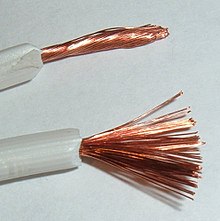Electrical conductor
An electrical conductor is a material that offers little resistance to the movement of electric charge. Its atoms are characterized by having few electrons in their valence shell, so it does not take much energy for them to jump from one atom to another.
Description
They are materials whose resistance to the passage of electricity is very low. The best electrical conductors are metals, such as copper, gold, iron, silver, and aluminum, and their alloys, although there are other non-metallic materials that also have the property of conducting electricity, such as graphite or solutions and saline solutions (for example, sea water).
To transport electrical energy, aluminum can be used, a metal that, although it has an electrical conductivity of the order of 60% of that of copper, is nevertheless a material three times lighter, so its use it is more indicated in overhead lines than in the transmission of electrical energy in high-voltage networks. Contrary to what many people believe, gold is a slightly worse conductor than copper; however, it is used in battery posts and electrical connectors due to its durability and "resistance" to corrosion.
The electrical conductivity of pure copper was adopted by the International Electrotechnical Commission in 1913 as the standard reference for this quantity, establishing the International Annealed Copper Standard, or IACS. According to this definition, the conductivity of annealed copper measured at 20 °C is equal to 58.0 MS/m. This value is what is called 100% IACS and the conductivity of the rest of the materials is expressed as a certain percentage of IACS. Most metals have conductivity values less than 100% IACS but there are exceptions such as silver or the special very high conductivity coppers designated C-103 and C-110.
Conducting materials
| Material | ρ [Ω·m] at 20 °C | σS/m] at 20 °C |
|---|---|---|
| Silver, Ag | 1.59 × 10−8 | 6.30 × 107 |
| Copper, Cub | 1.68 × 10−8 | 5.96 × 107 |
| Aluminium, Al | 2.82 × 10−8 | 3.50 × 107 |
Conductive materials include metals, electrolytes, superconductors, semiconductors, plasmas, and some non-metallic conductors such as graphite and conductive polymers.
Copper has a high electrical conductivity. Annealed copper is the international standard against which all other electrical conductors are compared; the International Standard conductivity for annealed copper is 58 MS/m, although ultra-pure copper can slightly exceed 101% IACS. The primary grade of copper used for electrical applications, such as building wires, electric motor windings, cables, and bus bars, is oxygen-free copper (CW004A or ASTM designation C100140). If high conductivity copper is to be soldered or soldered or used in a reducing atmosphere, then oxygen-free high conductivity copper (CW008A or ASTM designation C10100) may be used. Due to its ease of connection by soldering or clamping, the Copper is still the most common choice for most light gauge cables.
Silver is 6% more conductive than copper, but due to its cost it is not practical in most cases. However, it is used in specialized equipment, such as for artificial satellites, and as a thin plating to mitigate skin loss at high frequencies. Famously, 14,700 short tons (13,335.6 t) of silver on loan from the United States Department of the Treasury was used in the manufacture of calutron magnets during World War II due to wartime copper shortages.
Aluminum cable is the most common metal used in electrical power transmission and distribution. Although it only has 61% the conductivity of copper per cross-sectional area, its lower density makes it twice as conductive per mass. Since aluminum is approximately one third the cost of copper by weight, the economic advantages are considerable when large conductors are required.
The disadvantages of aluminum cabling lie in its mechanical and chemical properties. It easily forms an insulating oxide, causing connections to heat up. Its higher coefficient of thermal expansion than the brass materials used for connectors causes connections to loosen. Aluminum can also 'creep', slowly deforming under load, which also loosens connections. These effects can be mitigated by properly designed connectors and extra care in installation, but they have made aluminum building wiring unpopular beyond the drop line.
Organic compounds such as octane, which has 8 carbon and 18 hydrogen atoms, cannot conduct electricity. Oils are hydrocarbons, since carbon has the tetracovalent property and forms covalent bonds with other elements such as hydrogen, since it does not lose or gain electrons, so it does not form ions. Covalent bonds are simply the exchange of electrons. Therefore, there is no separation of ions when electricity is passed through it. Liquids made up of compounds that only have covalent bonds cannot conduct electricity. In contrast, some organic ionic liquids can conduct electrical current.
Although pure water is not electrically conductive, even a small amount of ionic impurities, such as salt, can quickly make it conductive.
Resistivity of the most common conductors
- Silver 1.64 × 10-8 Ω m
- Copper 1.72 × 10-8 Ω m
- Gold 2.45 × 10-8 Ω m
- Aluminium 2.8 × 10-8 Ω m
- Tiny 11.50 × 10-8 Ω m
- Graphite 60 × 10-6 Ω m
- Iron 8.90 × 10-8 Ω m
Composite conductors
A conductive material that combines the advantages of aluminum and copper, the result of a variant of wire drawing, it is composed of aluminum in most of the volume, but with a thin layer of copper on the outside. In large buildings, it is advisable to carry out the electrical supply with bars and not with cables that are too thick and difficult to handle.
Functions
Driver Applications:
- Drive electricity from one point to another (pass electrons through the driver; electrons flow due to potential difference).
- Create electromagnetic fields by forming coils and electromagnets.
- Modify the tension by forming transformers.
Contenido relacionado
Transverse engine
Nuclear energy
Robert hooke
